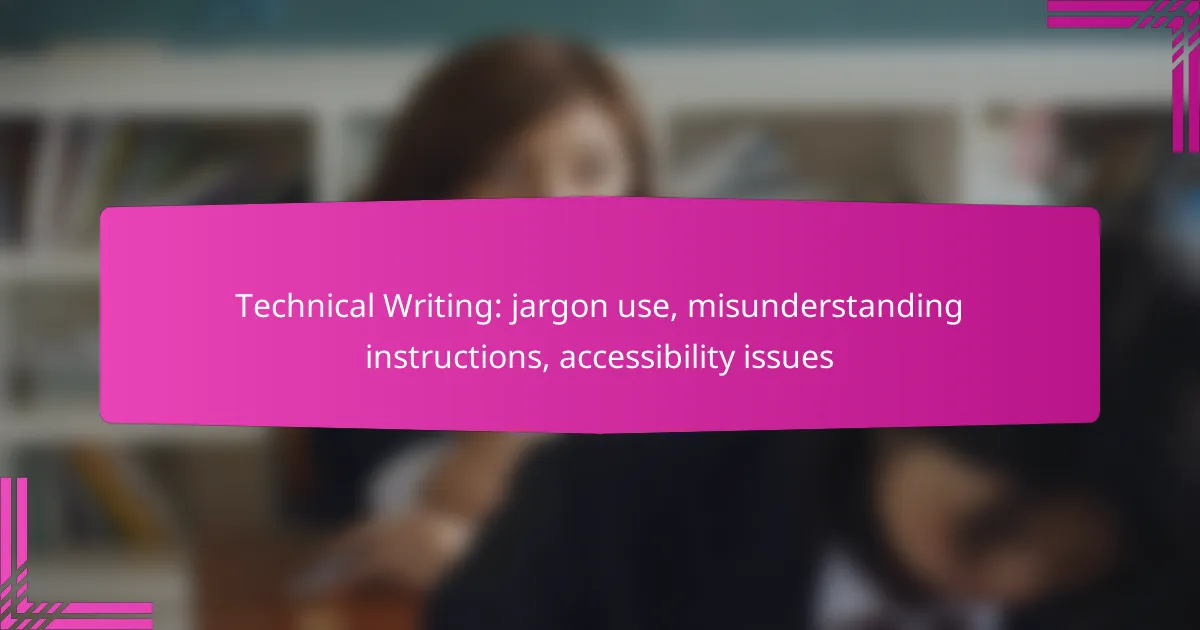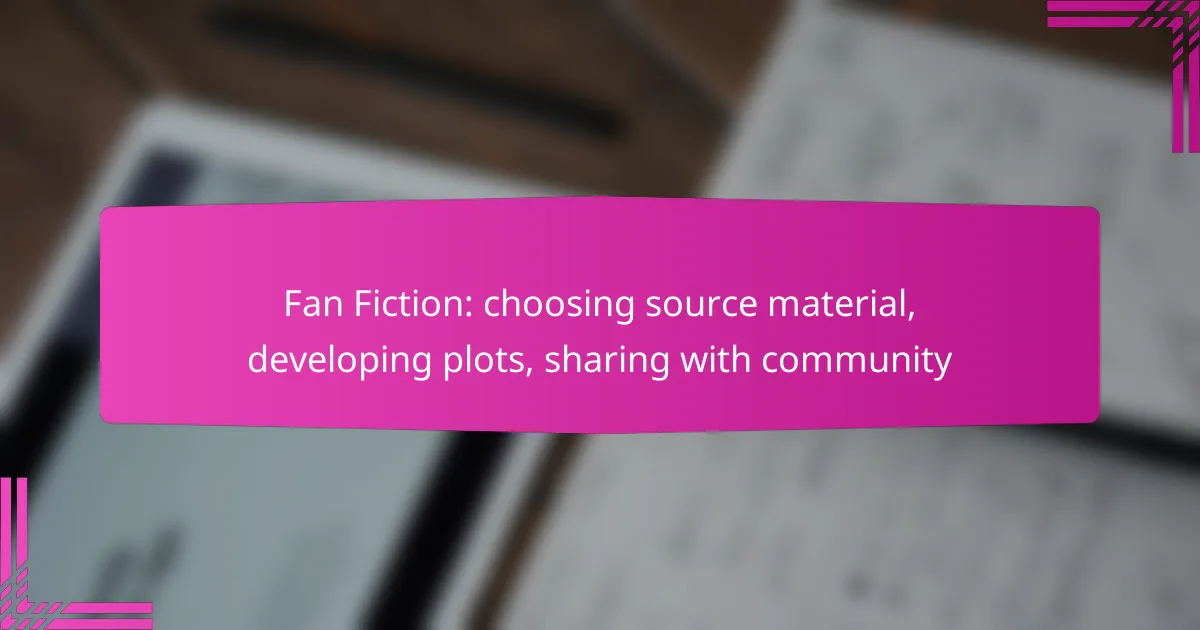Effective technical writing requires clarity and accessibility to ensure that all users can understand and follow instructions accurately. By minimizing jargon and addressing common misunderstandings, writers can enhance comprehension and reduce frustration. Additionally, implementing accessibility guidelines allows content to be inclusive, catering to diverse audiences and their varying needs.

How can jargon be effectively minimized in technical writing?
Minimizing jargon in technical writing involves using clear language that is easily understood by the intended audience. This approach enhances comprehension and ensures that instructions are followed correctly, reducing the risk of misunderstandings.
Use plain language principles
Plain language principles focus on clarity and simplicity. Writers should use common words and short sentences to convey complex ideas. For example, instead of saying “utilize,” simply say “use.” This helps ensure that readers can grasp the content without needing specialized knowledge.
Additionally, organizing information logically and using headings can guide readers through the material. Bullet points can also break down dense information into digestible parts, making it easier to follow.
Implement glossaries for complex terms
Glossaries serve as helpful references for readers encountering specialized terminology. Including a glossary at the end of a document allows users to quickly look up definitions without interrupting their reading flow. This is particularly useful in fields like technology or medicine, where jargon can be prevalent.
When creating a glossary, prioritize terms that are essential for understanding the content. Ensure that definitions are concise and written in plain language to maintain accessibility.
Engage user feedback for clarity
User feedback is crucial for identifying areas where jargon may confuse readers. Conducting usability tests or surveys can reveal which terms or phrases are unclear. Engaging with a diverse audience can provide insights into different levels of understanding and help refine the writing.
Encourage readers to share their experiences with the material. This feedback loop allows writers to make necessary adjustments, ensuring that the final product is accessible and effective for all users.

What are common misunderstandings in technical instructions?
Common misunderstandings in technical instructions often stem from unclear language and assumptions about the user’s prior knowledge. These issues can lead to confusion, errors, and frustration, making it essential to address them effectively.
Ambiguous language leads to confusion
Ambiguous language in technical instructions can create significant barriers for users. When terms are not clearly defined or when instructions are open to interpretation, users may misinterpret the intended actions. For example, phrases like “install the software” without specifying the operating system can leave users unsure of how to proceed.
To minimize confusion, use precise language and define any technical jargon. Instead of saying “connect the device,” specify “connect the USB cable from the device to the computer’s USB port.” This clarity helps users follow instructions accurately.
Assumed knowledge can mislead users
Assuming that users possess certain knowledge can lead to misunderstandings and errors. For instance, if a manual presumes familiarity with specific software or hardware without providing context, users may struggle to complete tasks. This is particularly problematic for novice users who may not have the same background as experienced users.
To avoid this pitfall, provide context and background information where necessary. Clearly outline prerequisites and consider including a glossary of terms. This approach ensures that all users, regardless of their experience level, can understand and follow the instructions effectively.

How can accessibility issues be addressed in technical writing?
Accessibility issues in technical writing can be addressed by following established guidelines, incorporating alternative text for visual elements, and providing content in various formats. These strategies ensure that all users, including those with disabilities, can effectively engage with the material.
Adopt WCAG guidelines for inclusivity
Adopting the Web Content Accessibility Guidelines (WCAG) is essential for creating inclusive technical documents. These guidelines provide a framework to ensure that content is perceivable, operable, understandable, and robust for all users, including those with disabilities.
Key principles include using sufficient color contrast, ensuring text is resizable, and providing keyboard navigation options. Regularly testing content against these guidelines can help identify and rectify potential accessibility barriers.
Utilize alternative text for images
Alternative text (alt text) is crucial for making images accessible to users with visual impairments. It provides a textual description of images, allowing screen readers to convey the content and function of visuals to users who cannot see them.
When writing alt text, be concise yet descriptive, focusing on the image’s purpose. For example, instead of “image of a dog,” use “a golden retriever playing fetch in a park.” This approach enhances understanding and engagement for all users.
Provide content in multiple formats
Offering content in multiple formats increases accessibility for diverse audiences. Consider providing documents in formats such as HTML, PDF, and audio to cater to different user needs and preferences.
When creating these formats, ensure that each version maintains the same level of accessibility. For instance, PDFs should be tagged properly for screen readers, and audio versions should include clear narration. This flexibility allows users to choose the format that best suits their abilities and circumstances.

What frameworks can improve technical writing quality?
Frameworks that enhance technical writing quality focus on clarity, consistency, and accessibility. Structured writing techniques and peer review processes are two effective methods that can significantly elevate the quality of technical documents.
Use structured writing techniques
Structured writing techniques involve organizing content in a clear, logical manner that enhances readability. This can include using headings, bullet points, and numbered lists to break down complex information into digestible parts. For instance, presenting steps in a process as a numbered list can help readers follow along easily.
Consider adopting a modular approach, where content is divided into self-contained sections. This allows for easier updates and modifications without affecting the entire document. Additionally, using consistent terminology and formatting across documents can help reduce confusion and improve user comprehension.
Implement peer review processes
Implementing peer review processes involves having colleagues review technical documents before finalization. This practice can identify unclear language, jargon misuse, and potential accessibility issues that the original writer may overlook. A fresh set of eyes can provide valuable feedback on the document’s clarity and effectiveness.
To make peer reviews more effective, establish clear guidelines for reviewers, such as focusing on specific sections or aspects of the writing. Consider using checklists that address common pitfalls, like jargon usage or instruction clarity. This structured feedback can lead to significant improvements in the overall quality of the technical writing.

How does technical writing vary across industries in Australia?
Technical writing in Australia varies significantly across industries due to differing regulatory requirements, jargon, and standards. Each sector has its own conventions that shape how information is communicated, affecting clarity and accessibility for the intended audience.
Differences in regulatory requirements
Regulatory requirements dictate how technical documents must be structured and what content they must include. For instance, the healthcare industry in Australia is governed by strict guidelines from the Therapeutic Goods Administration (TGA), which mandates specific formats and terminologies for medical documentation.
In contrast, the construction industry must adhere to local building codes and safety regulations, which can vary by state. This means technical writers must be familiar with both national standards and local laws to ensure compliance and avoid legal issues.
Industry-specific jargon and standards
Each industry has its own set of jargon and standards that technical writers must navigate. For example, the IT sector often uses terms like “API” and “cloud computing,” which may not be understood by those outside the field. Writers must balance the use of technical language with the need for clarity, especially when addressing a broader audience.
Moreover, industries like finance and engineering have specific documentation standards, such as the use of ISO norms or financial reporting guidelines. Understanding these standards is crucial for producing effective technical documents that meet industry expectations.

What emerging trends are shaping technical writing?
Emerging trends in technical writing are significantly influenced by advancements in technology, user experience design, and the integration of multimedia. These trends aim to enhance clarity, accessibility, and engagement in technical documentation.
Increased use of AI tools for content creation
The adoption of AI tools in technical writing is on the rise, allowing writers to automate repetitive tasks and generate content more efficiently. These tools can assist in drafting, editing, and even personalizing documents based on user preferences.
However, while AI can enhance productivity, it’s crucial to maintain a human touch in technical writing. Writers should review AI-generated content for accuracy and clarity to avoid potential misunderstandings.
Focus on user-centered design principles
User-centered design principles are becoming essential in technical writing, emphasizing the importance of understanding the audience’s needs. This approach involves creating documentation that is intuitive, easy to navigate, and tailored to the user’s context.
To implement user-centered design, writers should conduct user research, gather feedback, and iterate on their content. This ensures that instructions are clear and accessible, reducing the likelihood of misinterpretation.
Integration of multimedia elements for engagement
Incorporating multimedia elements, such as videos, infographics, and interactive content, is increasingly common in technical writing. These elements can enhance understanding and retention by catering to different learning styles.
When using multimedia, it’s important to ensure that all elements are accessible. This includes providing captions for videos and ensuring that images have descriptive alt text. Balancing text with multimedia can create a more engaging and informative experience for users.



